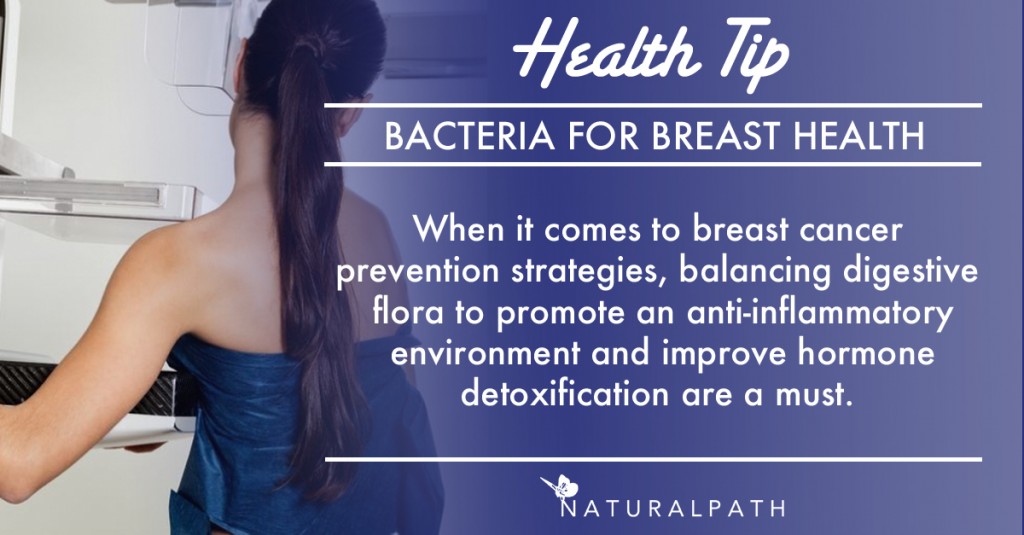One in eight women. This statistic is the number of women who will experience breast cancer in their lifetime. Dramatically higher than in the past, this statistic also has physicians and researchers hunting down causes and solutions for this disturbing rise.
Researchers have identified some known risks. There are genetic predispositions as well as obesity, diabetes and insulin resistance and links with low Vitamin D status and hormone imbalances. We know that many breast cancers like to grow when exposed to higher levels of female hormones as well as insulin, the hormone that regulates blood sugar. While these connections certainly can explain a portion of the increase, there may be another component at work, our bacteria!
Bacteria as medicine
Bacteria was a dirty word for many years, but now we realize that they outnumber our cells on our bodies 10:1. Our microbiome is a powerful determinant in our health and disease state. It makes sense that is could contribute greatly to our risk of cancer or aid in prevention.
The link between breast health and the microbiome was first discovered in 2006, when mice were introduced to pathogenic bacteria and consistently developed breast tumors. By 2013, researchers have now determined that the microbiome, the bacteria that lives in us, is indeed a modulator for cancer risk. This means a healthy digestive tract and microbiome can help prevent cancer, but an unhealthy GI tract and pathogenic bacteria would increase a person’s risk. The microflora in digestive tracts have a direct connection to breast health.
There have been many parts of the body that researchers and scientists have been evaluating as site of microflora. The gastrointestinal tract, vaginal canal, mouth and skin have been some of the major areas of research. More recently breast tissue, previously thought to be sterile, has been studied. Not only was healthy breast tissue studied, but cancerous tissue was studied as well. Researchers found that cancerous tissue had less overall bacteria compared to healthy tissue. Also, cancerous tissue was more likely to contain Methylobacterium radiotolerans, a bacterium known to invade immune suppressed tissue.
Another bacterium, Sphingomonas yanoikuyae, was also found in healthy breast tissue. It is now being researched as a potential breast probiotic, as it helps degrade pollutants in the environment and possible help modulate estrogen locally as well.
Hormone Detox and Bacteria
One mechanism of how bacteria influence hormones has been well explored, detoxification of hormones. The liver has a series of shoots and ladders that it uses to carve up and send off anything is no longer wants in the body, including hormones to plastics. One of the major pathways is known as glucuronidation. The liver attaches glucuronic acid to the targeted hormone or chemical, so that it can be transported through bile into the intestines. At this point, the liver did its job and considers the hormone, toxin or whatever waste product it wanted gone, processed and cleared.
In the intestines, bacteria interact with the cells lining our intestines as well as the waste products passing through. This is one of the major areas of study in the microbiome, as certain bacteria change how we clear our waste.
Beta-glucuronidase is an enzyme that breaks the bond between a waste product and the glucuronic acid the liver attached to it. This enzyme is produced by certain bacteria in the GI tract. If it is present, the hormone or toxin is liberated from being bound to glucuronic acid and is often reabsorbed into the body. The liver now has to re-process it in order to clear it.
It’s hard to ever look at a process or mechanism in the body as “good” or “bad”, however in the case of beta-glucuronidase having women reabsorb their estrogen that they are trying to detox, it is not a good thing. It is a cause of increased estrogen levels and hormone imbalance in women, and thus an increased risk of breast cancer.
This enzyme and activity in the intestines can be measured using a simple stool test. This helps physicians and patients understand if they need to address intestinal clearance of estrogen or if the patient should focus on other preventative measures. Beta-glucuronidase is lowered by healthy bacteria like L. acidophilus as well as many bifidobacterium species. The most effective means of lowering this enzyme is with a high vegetable diet, specifically onions, garlic, greens, apples and oranges, which are high in glucuronic acid. There are also supplements containing glucuronic acid, such as calcium d-glucarate.
One of the main tenants of naturopathic medicine is to treat the whole person. As we study the microbiome, this principle continues to be reinforced and almost expanded to include our microbiome and our environment.
 Dr. Lauren Young studied health psychology at the University of Connecticut and was involved in research on cardiovascular health at UCONN Medical Center. She received her doctorate in naturopathic medicine from the University of Bridgeport. Dr. Young has studied in many integrative settings, from acupuncture for detoxification at Lincoln Memorial Hospital to naturopathic care at Yale affiliated Griffin Hospital.
Dr. Lauren Young studied health psychology at the University of Connecticut and was involved in research on cardiovascular health at UCONN Medical Center. She received her doctorate in naturopathic medicine from the University of Bridgeport. Dr. Young has studied in many integrative settings, from acupuncture for detoxification at Lincoln Memorial Hospital to naturopathic care at Yale affiliated Griffin Hospital.
Dr. Young is a board certified licensed naturopathic physician in the state of Connecticut and has a family practice in Manchester. She lectures extensively through the Greater Harford area and writes for the Natural Nutmeg as well as the National Naturopathic board exams and the National MS Society. Dr. Young is clinical faculty for the residency program at Manchester Hospital, teaching conventional physicians the importance of natural medicine for the University of New England. She uses her expertise in nutrition, botanical medicine, homeopathy and functional medicine along with conventional diagnostic skills and laboratory tests to offer individualized treatments for patients of all ages. Dr. Young specializes in autoimmune, GI and endocrine conditions as well as oncology and immunology. In her spare time, Dr. Young enjoys being a mother and wife, knitting, yoga and raising backyard chickens. She is very passionate about rescue animals and patient advocacy.
Dr. Young and Dr. Ashley Burkman practice as fully licensed Naturopathic Physicians at Connecticut Natural Health Specialists, LLC, in Manchester, CT. Most major health insurances accepted. New patients are encouraged to call for an appointment.
References:
- Heerdt, A, Young, C, Borgen, P. Calcium glucarate as a chemopreventive agent in breast cancer. National Center for Biotechnology Information. 1995. Available at: http://www.ncbi.nlm.nih.gov/pubmed/7744577. Accessed October 10, 2015.
- Walaszek, Z. Result FiltersPotential use of D-glucaric acid derivatives in cancer prevention. National Center for Biotechnology Information. 1990. Available at: http://www.ncbi.nlm.nih.gov/pubmed/2208084. Accessed October 10, 2015.
- Abou-Issa, H, Moeschberger , M, el-Masry, W, Tejwani, S, Curley, R, Webb , T. Result FiltRelative efficacy of glucarate on the initiation and promotion phases of rat mammary carcinogenesis. National Center for Biotechnology Information. 1995. Available at: http://www.ncbi.nlm.nih.gov/pubmed/7645962. Accessed October 10, 2015.
- Schneider, AP, Zainer, CM, Kubat, CK, Mullen, NK, Windisch, AK. The breast cancer epidemic: 10 facts. The Linacre Quarterly. 2014;81(3):244–277. doi:10.1179/2050854914y.0000000027.

